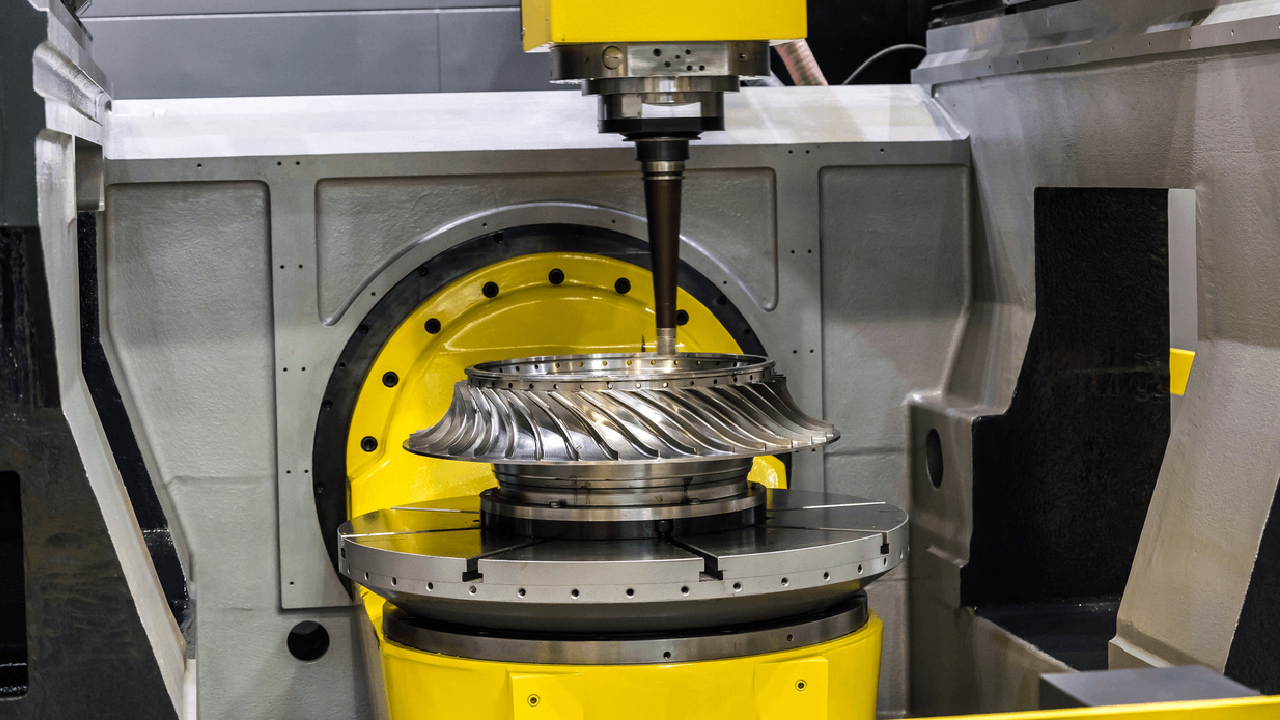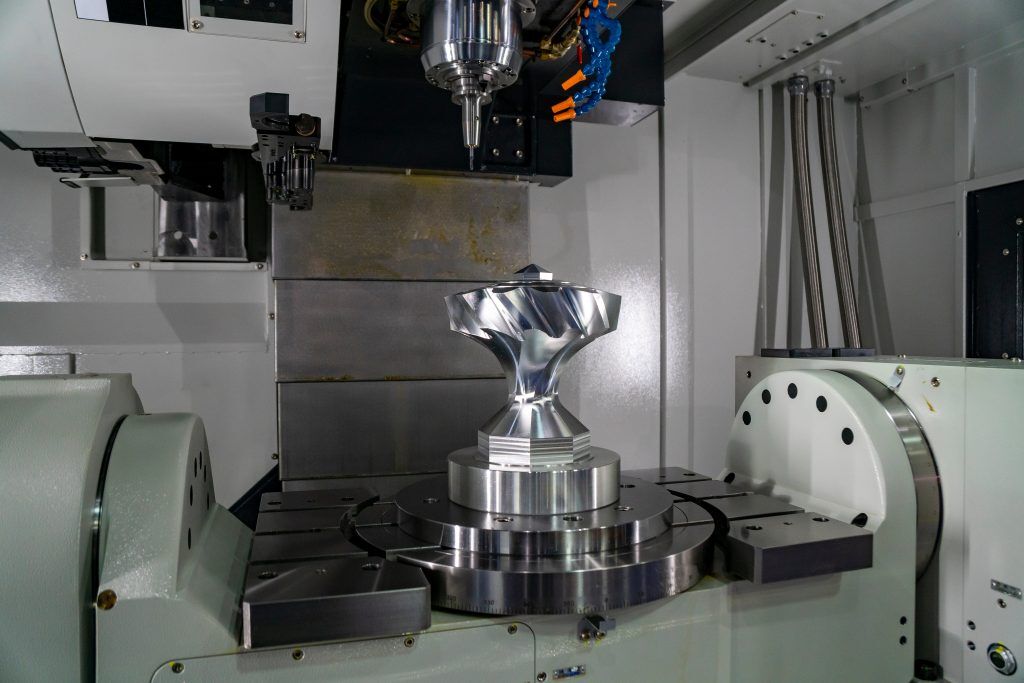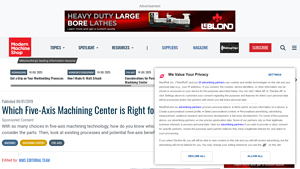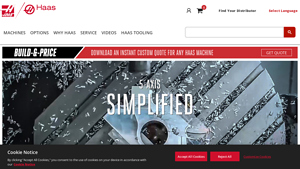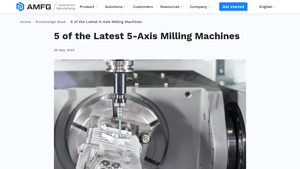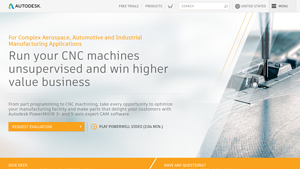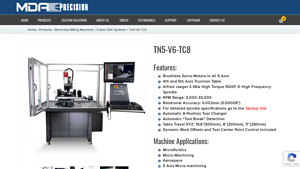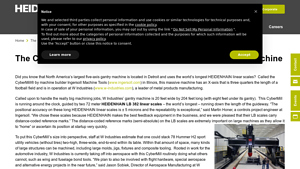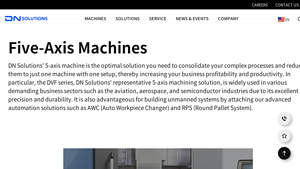Best 5 Axis Cnc Machine Guide: Type, Cost, Top List…
Introduction: Navigating the Global Market for best 5 axis cnc machine
In today’s competitive landscape, sourcing the best five-axis CNC machine can be a daunting challenge for international B2B buyers. With advancements in machining technology, businesses must navigate a myriad of options to find the right fit for their specific applications, whether in aerospace, automotive, or complex prototyping. This comprehensive guide delves into the essential factors to consider, including machine types, applications, supplier vetting processes, and cost analysis.
By examining the intricacies of five-axis machining—from understanding the differences between 3+2 and full simultaneous control to evaluating the benefits of shorter tooling—this guide empowers buyers to make informed purchasing decisions. It highlights the advantages of five-axis machining, such as reduced setup times and enhanced precision, which can significantly impact productivity and profitability.
Particularly for buyers in Africa, South America, the Middle East, and Europe, such as Germany and Brazil, understanding these elements is crucial to securing machines that align with their operational needs and business goals. With actionable insights and a focus on supplier reliability, this guide serves as a vital resource for companies looking to elevate their manufacturing capabilities and stay ahead in a rapidly evolving market.
Understanding best 5 axis cnc machine Types and Variations
| Type Name | Key Distinguishing Features | Primary B2B Applications | Brief Pros & Cons for Buyers |
|---|---|---|---|
| 3+2 Machining Center | Combines three-axis machining with a tilting rotary table | Aerospace, Medical Devices, Prototyping | Pros: Cost-effective, simpler setup; Cons: Limited simultaneous machining capabilities. |
| Full Simultaneous 5-Axis | Allows full simultaneous motion of all five axes | Complex Aerospace Components, Molds, Dies | Pros: High precision, flexible tool positioning; Cons: Higher cost and complexity in programming. |
| Gantry-Style 5-Axis | Features a large, stationary table with moving gantry | Large Part Machining, Automotive, Heavy Equipment | Pros: Handles large and heavy workpieces; Cons: Requires significant floor space. |
| Articulating Head Machines | Utilizes a rotating head for enhanced tool access | Precision Parts, Medical Implants | Pros: Excellent for complex geometries; Cons: More expensive and maintenance-intensive. |
| Horizontal Machining Center | Horizontal orientation for better chip management | Heavy Duty Machining, Aerospace, Defense | Pros: Improved tool life, faster chip removal; Cons: Limited vertical reach. |
What are the Key Characteristics of 3+2 Machining Centers?
3+2 machining centers integrate a three-axis setup with a tilting rotary table, allowing operators to access five sides of a workpiece without repositioning it multiple times. This configuration is particularly suitable for small to medium-sized parts, making it ideal for industries like aerospace and medical device manufacturing. When considering a purchase, buyers should evaluate their production volume and complexity, as this machine type offers a cost-effective solution with a straightforward setup.
How Does Full Simultaneous 5-Axis Machining Benefit Complex Applications?
Full simultaneous 5-axis machining provides dynamic control over all five axes, enabling intricate contouring and precise machining of complex parts. This technology is widely used in industries requiring high accuracy, such as aerospace and mold-making. Buyers should consider the machine’s programming capabilities and the level of expertise required for operation, as this option typically involves a steeper learning curve and higher initial investment.
Why Choose Gantry-Style 5-Axis Machines for Large Parts?
Gantry-style 5-axis machines feature a robust structure with a stationary table and a moving gantry, making them ideal for handling large and heavy workpieces. This design is particularly beneficial in automotive and heavy equipment industries. Buyers should assess their floor space and production needs, as these machines can occupy significant real estate but offer unparalleled support for large components.
What Advantages Do Articulating Head Machines Provide?
Articulating head machines use a rotating tool head to enhance access to complex geometries, making them ideal for precision parts such as medical implants. This type of machine is suitable for manufacturers looking to produce intricate designs efficiently. However, potential buyers should weigh the higher costs and maintenance demands against the benefits of increased machining flexibility.
How Does a Horizontal Machining Center Optimize Production?
Horizontal machining centers are designed with a horizontal spindle orientation, which improves chip removal and enhances tool life. This configuration is particularly effective for heavy-duty machining applications in aerospace and defense sectors. When considering a horizontal machining center, buyers should evaluate their specific machining needs and the potential for increased production efficiency, balanced against the limitations in vertical reach.
Key Industrial Applications of best 5 axis cnc machine
| Industry/Sector | Specific Application of best 5 axis cnc machine | Value/Benefit for the Business | Key Sourcing Considerations for this Application |
|---|---|---|---|
| Aerospace | Manufacturing complex aircraft components | Reduces setup time and enhances precision for intricate designs | Consider machine weight capacity and accuracy requirements |
| Automotive | Production of high-performance engine components | Enables rapid prototyping and high-quality finishes | Evaluate tooling compatibility and material versatility |
| Medical Devices | Fabrication of orthopedic implants and surgical instruments | Allows for the creation of complex geometries and custom parts | Assess biocompatibility of materials and precision needs |
| Mold and Die Making | Creation of molds for plastic injection | Streamlines production processes and reduces lead times | Focus on machine rigidity and thermal stability |
| Energy Sector (Renewable) | Production of turbine components for wind energy | Facilitates the machining of large, complex parts efficiently | Ensure capability for large part handling and precision |
How is the Best 5 Axis CNC Machine Used in Aerospace Manufacturing?
In the aerospace industry, best 5 axis CNC machines are essential for producing complex aircraft components such as turbine blades and fuselage parts. These machines enable manufacturers to achieve high precision and intricate designs that are often required in aerospace applications. By reducing setup time and the potential for errors, companies can enhance productivity and maintain stringent quality standards. International buyers should prioritize machines with robust weight capacities and high accuracy to meet the demanding specifications of aerospace projects, particularly in regions like Europe and the Middle East where aerospace manufacturing is prevalent.
What Role Does 5 Axis CNC Machining Play in Automotive Production?
The automotive sector benefits significantly from the use of best 5 axis CNC machines for producing high-performance engine components and other intricate parts. These machines allow for rapid prototyping and the ability to create complex geometries that traditional machining methods struggle to achieve. By enabling faster production cycles and higher quality finishes, automotive manufacturers can stay competitive in a rapidly evolving market. Buyers from South America and Africa should evaluate the tooling compatibility and material versatility of machines to ensure they can handle the diverse requirements of automotive applications.
How is 5 Axis CNC Technology Revolutionizing Medical Device Manufacturing?
In the medical device sector, best 5 axis CNC machines are crucial for fabricating orthopedic implants and surgical instruments that require high precision and complex geometries. The ability to create custom parts efficiently is a significant advantage, as it allows manufacturers to respond quickly to specific patient needs and regulatory requirements. For international buyers, especially from regions like Europe, it is important to assess the biocompatibility of materials used in production and ensure that machines meet the high precision standards mandated by medical regulations.
What Advantages Does 5 Axis CNC Machining Offer in Mold and Die Making?
In mold and die making, best 5 axis CNC machines streamline the production of molds for plastic injection, significantly reducing lead times and enhancing production efficiency. These machines allow for the machining of complex mold geometries in a single setup, eliminating the need for multiple setups that can introduce errors. Buyers should focus on sourcing machines with strong rigidity and thermal stability, as these features are critical for maintaining accuracy during the machining of intricate molds, particularly in competitive markets across Africa and South America.
How Can the Energy Sector Benefit from 5 Axis CNC Machining?
In the renewable energy sector, particularly in the production of turbine components for wind energy, best 5 axis CNC machines play a vital role. They facilitate the efficient machining of large and complex parts, which is essential for the performance and reliability of energy systems. Companies looking to invest in such technology should ensure that the machines can handle large part sizes while maintaining precision. This is especially relevant for international buyers in regions like Europe, where renewable energy initiatives are rapidly expanding.
3 Common User Pain Points for ‘best 5 axis cnc machine’ & Their Solutions
Scenario 1: Navigating Complexity in Part Specifications
The Problem: B2B buyers often struggle with selecting the right five-axis CNC machine that meets the specific requirements of their projects. With a plethora of models available, each with varying capabilities, features, and configurations, it can be overwhelming to determine which machine will best handle the size, weight, and intricacy of the parts they need to produce. Additionally, buyers may lack the technical knowledge to assess whether a machine’s specifications align with their production needs, leading to potential misinvestments.
The Solution: To effectively navigate this complexity, buyers should start by conducting a thorough analysis of their current and future project specifications. This includes understanding the dimensions and weights of the parts, the required tolerances, and the intricacies of the design. Once these parameters are established, buyers can consult with manufacturers or distributors who specialize in five-axis CNC machines. Requesting a detailed comparison of different models based on the specific applications can provide clarity. Additionally, buyers should consider visiting machine demonstrations or exhibitions to see the machines in action, which can offer invaluable insights into their capabilities. Utilizing CAD/CAM software simulations may also help visualize how different machines would perform on their parts, allowing for more informed decision-making.
Scenario 2: Overcoming High Initial Investment Costs
The Problem: One of the most significant barriers for B2B buyers in acquiring the best five-axis CNC machines is the high initial investment cost. Many companies, especially small to medium-sized enterprises, find it challenging to justify the upfront expenditure, particularly when budget constraints are tight. This situation is exacerbated by concerns over return on investment (ROI), as buyers may be unsure if the machine’s capabilities will translate into increased productivity and profitability.
The Solution: To alleviate financial concerns, buyers should consider a phased approach to investment. This involves initially acquiring a machine that meets their basic needs—such as a 3+2 configuration—allowing them to gain experience with five-axis machining without committing to the full cost of a high-end simultaneous five-axis model. Furthermore, buyers can explore financing options, such as leasing or installment plans, which can spread the cost over time and improve cash flow. Additionally, buyers should conduct a cost-benefit analysis, estimating potential gains from reduced setup times, improved machining accuracy, and increased production capabilities. This analysis can provide a clearer picture of long-term ROI, helping to justify the investment.
Scenario 3: Ensuring Operator Proficiency and Training
The Problem: After purchasing a five-axis CNC machine, many B2B buyers face the challenge of ensuring their operators are proficient in using this advanced technology. The complexity of programming and operating five-axis machines often necessitates specialized training, which can be time-consuming and costly. Buyers may worry that insufficient operator skills could lead to production delays, increased waste, and machine misuse, ultimately undermining the investment.
The Solution: To ensure operators are well-equipped to handle five-axis CNC machines, buyers should prioritize comprehensive training programs. This can include collaborating with the machine manufacturer for tailored training sessions, which often cover machine operation, programming techniques, and best practices for maintenance. Establishing a mentorship program where experienced operators guide newer team members can also enhance learning and retention of skills. Furthermore, investing in user-friendly software and simulation tools can facilitate a more accessible learning curve. Buyers should also consider ongoing training as a standard practice, integrating it into their operational routines to keep skills updated as technology evolves. This approach not only maximizes the machine’s capabilities but also fosters a culture of continuous improvement within the workforce.
Strategic Material Selection Guide for best 5 axis cnc machine
What Are the Key Materials for Best 5 Axis CNC Machines?
When selecting materials for components machined by five-axis CNC machines, it is crucial to consider properties that affect performance, durability, and cost. Below is an analysis of three common materials used in this context: Aluminum, Steel, and Titanium.
How Does Aluminum Perform in Five-Axis CNC Machining?
Aluminum is one of the most widely used materials in CNC machining due to its favorable properties. It has a low density, excellent corrosion resistance, and good thermal conductivity. The material is easy to machine, allowing for high-speed operations and intricate designs.
Pros and Cons: Aluminum’s lightweight nature makes it ideal for applications where weight is a concern, such as in aerospace or automotive industries. However, it can be less durable than steel and may not withstand high-temperature applications. Additionally, while it is generally cost-effective, the price can vary significantly based on the alloy chosen.
Impact on Application: Aluminum is compatible with various media, including water and oils, making it suitable for a range of applications. However, it may not perform well in environments with high abrasion or extreme temperatures.
Considerations for International Buyers: Buyers from regions like Africa and South America should be aware of the specific aluminum grades that comply with local standards, such as ASTM or ISO. In Europe, particularly Germany, preferences may lean towards specific alloys known for their mechanical properties.
What About Steel as a Material Choice?
Steel is another popular choice for five-axis CNC machining due to its strength and versatility. It offers excellent wear resistance and can withstand high-pressure applications, making it suitable for heavy-duty components.
Pros and Cons: The durability of steel is a significant advantage, particularly for parts that experience high stress. However, steel is heavier than aluminum, which can be a disadvantage in weight-sensitive applications. The machining process can also be more complex, requiring specialized tools and longer machining times, which can increase costs.
Impact on Application: Steel is compatible with a wide range of media, including corrosive environments, especially when treated with protective coatings. This makes it suitable for industries such as oil and gas, where durability is critical.
Considerations for International Buyers: Compliance with standards like DIN or JIS is essential for buyers in Europe and the Middle East. Additionally, understanding the local availability of specific steel grades can impact lead times and costs.
How Does Titanium Compare in CNC Machining?
Titanium is renowned for its high strength-to-weight ratio and corrosion resistance, making it a preferred material for aerospace and medical applications. Its ability to withstand extreme temperatures and harsh environments is unmatched.
Pros and Cons: The primary advantage of titanium is its exceptional durability and resistance to corrosion, which is crucial for long-lasting applications. However, titanium is significantly more expensive than aluminum and steel, and its machining can be more challenging due to its toughness, often requiring specialized tooling.
Impact on Application: Titanium is compatible with various media, including saline environments, making it ideal for marine applications. Its biocompatibility also makes it suitable for medical implants.
Considerations for International Buyers: Buyers must consider the high cost of titanium and its availability in their regions. Compliance with international standards for medical applications or aerospace components is critical, particularly in Europe and North America.
Summary Table of Material Selection for Best 5 Axis CNC Machines
| Material | Typical Use Case for best 5 axis cnc machine | Key Advantage | Key Disadvantage/Limitation | Relative Cost (Low/Med/High) |
|---|---|---|---|---|
| Aluminum | Aerospace components, automotive parts | Lightweight, good corrosion resistance | Less durable than steel, temperature sensitive | Medium |
| Steel | Heavy-duty machinery, oil and gas components | High strength and wear resistance | Heavier, more complex machining process | Medium to High |
| Titanium | Aerospace, medical implants | Exceptional durability and corrosion resistance | High cost, challenging to machine | High |
This material selection guide provides key insights for international B2B buyers looking to optimize their five-axis CNC machining operations. Understanding the properties, advantages, and limitations of each material can lead to more informed purchasing decisions and better end-product quality.
In-depth Look: Manufacturing Processes and Quality Assurance for best 5 axis cnc machine
What Are the Main Stages in the Manufacturing Process of the Best 5 Axis CNC Machines?
Manufacturing a top-tier 5 axis CNC machine involves several critical stages, each designed to ensure precision, efficiency, and quality. The main stages include material preparation, forming, assembly, and finishing.
Material Preparation
The manufacturing process begins with selecting high-quality raw materials, typically aluminum or steel, known for their durability and machining properties. Materials undergo rigorous inspection to verify their compliance with specifications. This step is crucial, as any defects in raw materials can compromise the machine’s overall performance. Once approved, materials are cut to size, often using automated systems to ensure accuracy and minimize waste.
Forming Techniques
The next stage involves various forming techniques, including casting, machining, and welding. For 5 axis CNC machines, precision machining is the most critical technique. This process often utilizes advanced CNC machining centers to create components with tight tolerances. Techniques such as laser cutting and waterjet cutting may also be employed to achieve intricate designs and features. For larger components, welding processes are used to join parts, ensuring structural integrity and strength.
Assembly Processes
Once the individual components are ready, the assembly process begins. This stage is meticulous, requiring skilled technicians to ensure that every part fits correctly. Key components such as the spindle, rotary tables, and control systems are assembled in a controlled environment to prevent contamination and damage. It is essential to follow detailed assembly guidelines and use precise tools to maintain the quality of the machine.
Finishing Techniques
After assembly, the machine undergoes finishing processes, which may include painting, coating, and polishing. These techniques not only enhance the machine’s aesthetic appeal but also protect against corrosion and wear. Surface treatments are critical, especially for machines that will operate in harsh environments, such as those found in the Middle East or South America.
What Quality Control Standards Should B2B Buyers Look for in 5 Axis CNC Machines?
Quality assurance is paramount in the manufacturing of CNC machines. Buyers should look for compliance with international standards such as ISO 9001, which ensures a consistent quality management system. Additionally, industry-specific certifications like CE (Conformité Européenne) for the European market and API (American Petroleum Institute) for oil and gas applications are essential indicators of quality.
Quality Control Checkpoints
A robust quality control process includes several checkpoints throughout the manufacturing stages:
-
Incoming Quality Control (IQC): This initial step involves inspecting raw materials and components upon arrival to ensure they meet specified standards.
-
In-Process Quality Control (IPQC): During manufacturing, periodic checks are conducted to monitor processes and ensure they adhere to quality specifications. This might include checking tolerances, dimensions, and surface finishes.
-
Final Quality Control (FQC): Once the machine is fully assembled, a comprehensive inspection is performed to verify that all components function correctly and meet quality standards. This often includes performance testing under simulated conditions.
How Can B2B Buyers Verify Supplier Quality Assurance Practices?
B2B buyers must be proactive in verifying the quality assurance practices of their suppliers. Here are some effective strategies:
Conducting Audits
Regular audits of suppliers can provide insights into their quality management systems. Buyers should request to review the supplier’s quality management certifications, production processes, and previous audit reports. This transparency is crucial for establishing trust and ensuring that suppliers adhere to international quality standards.
Requesting Quality Reports
Buyers can also request quality assurance reports that document the results of inspections at various stages of manufacturing. These reports should detail any discrepancies found and the corrective actions taken, providing a clear picture of the supplier’s commitment to quality.
Engaging Third-Party Inspection Services
Utilizing third-party inspection services can further assure buyers of the quality of the machines. Independent inspectors can conduct thorough evaluations of the manufacturing process and final products, offering an unbiased assessment of compliance with quality standards.
What Are the Nuances of Quality Control for International B2B Buyers?
For international B2B buyers, particularly those from regions like Africa, South America, the Middle East, and Europe, understanding the nuances of quality control is essential. Different regions may have varying standards and regulations, impacting the quality assurance processes of suppliers.
Regional Standards and Compliance
Buyers should familiarize themselves with the specific quality standards and certifications required in their region. For example, European buyers may prioritize CE certification, while buyers in the Middle East might focus on compliance with local industry regulations. Understanding these nuances helps buyers ensure that their suppliers can meet regional requirements.
Cultural Considerations in Quality Assurance
Cultural differences can also influence quality assurance practices. Buyers should consider how local business practices and attitudes towards quality may affect their suppliers’ operations. Establishing clear communication and expectations can help bridge any gaps and foster a strong working relationship.
Conclusion: The Importance of Quality Assurance in Selecting a 5 Axis CNC Machine Supplier
Choosing the right supplier for a 5 axis CNC machine is not just about the machine’s capabilities; it is equally about the manufacturer’s commitment to quality assurance. By understanding the manufacturing processes, recognizing quality control standards, and actively verifying supplier practices, B2B buyers can make informed decisions that align with their business needs and market expectations. Investing time in these areas can yield significant long-term benefits, ensuring that the machines purchased are reliable, efficient, and capable of meeting the demands of a competitive global marketplace.
Practical Sourcing Guide: A Step-by-Step Checklist for ‘best 5 axis cnc machine’
When considering the procurement of a five-axis CNC machine, a structured approach can significantly enhance your decision-making process. This checklist serves as a practical guide for B2B buyers aiming to invest in the best five-axis CNC technology tailored to their operational needs.
Step 1: Define Your Technical Specifications
Before engaging with suppliers, it’s essential to have a clear understanding of your technical requirements. Assess the size, weight, and complexity of the parts you intend to machine.
– Considerations:
– What are the dimensions and material types?
– What precision levels are required for your operations?
Step 2: Evaluate Your Production Needs
Analyze your current and future production demands to determine the machine’s capacity. This includes understanding the volume of parts you will produce and the complexity of operations involved.
– Considerations:
– Will you be running high-volume production or short-run jobs?
– Are there specific industry standards or certifications your products must meet?
Step 3: Research Available Technologies
Familiarize yourself with the different types of five-axis CNC machines available, such as 3+2 machines or full simultaneous five-axis systems. Each technology offers distinct advantages depending on your machining needs.
– Considerations:
– What type of workpieces will you be machining?
– How does the technology align with your current machining capabilities?
Step 4: Identify Potential Suppliers
Create a shortlist of reputable suppliers who specialize in five-axis CNC machines. Look for companies with a strong track record in the industry and positive reviews from other businesses.
– Considerations:
– Check for supplier certifications and industry accolades.
– Investigate their customer support and service offerings.
Step 5: Request and Compare Quotes
Once you have identified potential suppliers, request detailed quotes that include specifications, pricing, delivery timelines, and warranty information.
– Considerations:
– Ensure that quotes are comparable by asking for the same specifications across all suppliers.
– Look for any hidden costs in installation, training, or maintenance.
Step 6: Verify Customer References and Case Studies
Before finalizing a supplier, seek out references and case studies that demonstrate their success in similar applications. This can provide insights into their reliability and customer satisfaction levels.
– Considerations:
– Ask for references from clients in your region or industry.
– Evaluate how the supplier has handled challenges in past projects.
Step 7: Plan for Installation and Training
Consider the logistics of installing the machine and the training required for your staff. Proper installation and training are crucial for maximizing the machine’s efficiency and lifespan.
– Considerations:
– What support does the supplier offer during installation?
– Are training programs available, and do they cater to varying levels of expertise?
By following this structured checklist, you can make an informed decision that aligns with your operational goals and enhances your competitive edge in the market.
Comprehensive Cost and Pricing Analysis for best 5 axis cnc machine Sourcing
What Are the Key Cost Components in Sourcing a 5 Axis CNC Machine?
When considering the sourcing of a five-axis CNC machine, understanding the cost structure is essential for making informed purchasing decisions. The primary cost components include:
-
Materials: The raw materials used in the construction of CNC machines significantly impact the overall cost. High-grade steel, aluminum, and advanced composites are common, with prices varying based on market conditions and supplier sourcing strategies.
-
Labor: Labor costs encompass both direct manufacturing labor and skilled engineering labor required for design and assembly. Depending on the region, labor rates can fluctuate, affecting the final price of the machine. Countries with a robust engineering workforce, like Germany, may have higher labor costs compared to emerging markets in Africa or South America.
-
Manufacturing Overhead: This includes utilities, rent, maintenance of machinery, and administrative costs associated with production. Efficient manufacturing processes can help minimize these overheads, leading to more competitive pricing.
-
Tooling: Specialized tooling and fixtures required for machining operations add to the overall cost. The complexity of the tooling, particularly for custom applications, can vary widely, influencing the final price.
-
Quality Control (QC): Rigorous quality control processes are necessary to ensure precision in five-axis machining. The costs associated with QC, including testing and certification, are integral to the machine’s overall expense.
-
Logistics: Shipping and handling costs are critical, especially for international buyers. These costs can vary significantly based on distance, shipping methods, and customs duties.
-
Margin: Suppliers typically build a margin into their pricing to account for risks and profit. Understanding the expected margins in your target markets can help in negotiating better deals.
How Do Price Influencers Affect Five Axis CNC Machine Costs?
Several factors influence the pricing of five-axis CNC machines:
-
Volume/MOQ: The minimum order quantity (MOQ) can affect pricing, with larger orders often leading to bulk discounts. Buyers should assess their production needs to negotiate effectively.
-
Specifications and Customization: Custom specifications can increase costs, particularly if specialized features or technologies are required. It’s vital to balance the need for customization with budget constraints.
-
Materials: The choice of materials not only impacts the machine’s durability but also its price. Premium materials may offer better performance but at a higher cost.
-
Quality and Certifications: Machines with higher quality standards and certifications (like ISO) tend to command higher prices. However, these may offer better longevity and performance, justifying the initial investment.
-
Supplier Factors: The reputation and reliability of the supplier can also influence pricing. Established suppliers may charge more, but they often provide better support and warranty services.
-
Incoterms: Understanding international commercial terms (Incoterms) is crucial. They define the responsibilities of buyers and sellers in international transactions, affecting total costs, including insurance and freight.
What Buyer Tips Can Help in Cost-Efficiency for Five Axis CNC Machines?
For international buyers, particularly from Africa, South America, the Middle East, and Europe, the following tips can enhance cost-efficiency:
-
Negotiation: Leverage volume purchases or long-term contracts to negotiate better pricing. Building a relationship with suppliers can lead to favorable terms.
-
Total Cost of Ownership (TCO): Evaluate the TCO, which includes purchase price, operational costs, maintenance, and potential downtime. A lower initial price may lead to higher long-term costs if the machine is less reliable or efficient.
-
Pricing Nuances for International Buyers: Be aware of currency fluctuations, import tariffs, and local taxes that may affect the total cost. Working with local distributors can also mitigate some of these risks.
-
Explore Financing Options: Investigate financing solutions that may allow for better cash flow management, enabling purchases without immediate full payment.
-
Request for Indicative Prices: Always request indicative prices from multiple suppliers to benchmark costs. Keep in mind that prices can vary based on specifications and regional factors.
In conclusion, a thorough understanding of the cost components and pricing influencers is vital for B2B buyers in sourcing the best five-axis CNC machines. By applying these insights and strategies, businesses can make more informed decisions that align with their operational needs and budget constraints.
Alternatives Analysis: Comparing best 5 axis cnc machine With Other Solutions
Introduction: Evaluating Alternatives to the Best 5 Axis CNC Machine
In the realm of precision machining, the best 5-axis CNC machines offer unparalleled capabilities for producing complex geometries and enhancing operational efficiency. However, they are not the only solution available to manufacturers. Exploring alternative technologies can provide insights into different methodologies that may suit specific business needs or budgets. This analysis will compare the best 5-axis CNC machines against two viable alternatives: traditional 3-axis CNC machines and additive manufacturing (3D printing).
Comparison Table
| Comparison Aspect | Best 5 Axis CNC Machine | Traditional 3-Axis CNC Machine | Additive Manufacturing (3D Printing) |
|---|---|---|---|
| Performance | High precision and complex part creation | Good for simpler geometries | Excellent for rapid prototyping and complex shapes |
| Cost | Higher initial investment, long-term cost savings | Lower upfront cost, but may incur more operational costs | Variable costs, often lower for low-volume production |
| Ease of Implementation | Requires skilled operators and training | Easier to set up and operate for basic tasks | Requires specialized software and design knowledge |
| Maintenance | Regular maintenance needed, but high reliability | Generally lower maintenance needs | Minimal, but dependent on material type |
| Best Use Case | Aerospace, automotive, and intricate parts | High-volume production of simpler parts | Prototyping, custom parts, and low-volume production |
Detailed Breakdown of Alternatives
Traditional 3-Axis CNC Machines
Traditional 3-axis CNC machines are the cornerstone of many manufacturing operations. They are well-suited for producing simpler parts that do not require intricate geometries. The main advantages of these machines include their lower initial cost and ease of use, making them accessible for small to medium-sized enterprises. However, they may necessitate multiple setups to achieve the desired complexity, which can increase labor costs and lead to longer lead times. For manufacturers focusing on high-volume production of straightforward components, 3-axis machines remain a reliable choice.
Additive Manufacturing (3D Printing)
Additive manufacturing, commonly known as 3D printing, has emerged as a revolutionary alternative for producing parts in a layer-by-layer approach. This method excels in creating complex geometries that are often unattainable with traditional subtractive manufacturing methods. The primary benefits include rapid prototyping capabilities and the ability to produce low-volume custom parts at a reduced cost. However, the initial investment in a 3D printer and the need for specialized design software can be barriers for some businesses. Additionally, while 3D printing is evolving, it may still fall short in terms of material strength and surface finish compared to machined parts.
Conclusion: Choosing the Right Solution for Your Needs
Selecting the appropriate machining solution hinges on various factors, including the complexity of the parts, production volume, and budget constraints. While the best 5-axis CNC machines offer advanced capabilities for high-precision applications, traditional 3-axis machines may suffice for simpler tasks, providing cost-effective solutions for businesses with straightforward machining needs. On the other hand, additive manufacturing presents an innovative avenue for rapid prototyping and custom parts, ideal for companies looking to explore new product designs without significant upfront investment. Ultimately, B2B buyers must assess their specific operational requirements, production goals, and available resources to determine which solution aligns best with their strategic vision.
Essential Technical Properties and Trade Terminology for best 5 axis cnc machine
What Are the Key Technical Properties of a High-Quality 5-Axis CNC Machine?
When evaluating the best 5-axis CNC machines for your operations, several critical specifications must be considered to ensure optimal performance and suitability for your manufacturing needs. Here are some essential technical properties:
-
Accuracy and Tolerance
Accuracy refers to how closely a machine can produce parts to the desired specifications. Tolerance is the allowable deviation from a standard. High accuracy and tight tolerances are crucial for industries such as aerospace and medical devices, where precision is non-negotiable. A machine with better accuracy reduces scrap rates and improves part quality, directly impacting production costs and customer satisfaction. -
Spindle Speed
Spindle speed, measured in revolutions per minute (RPM), determines how quickly a machine can cut through materials. Higher spindle speeds allow for faster machining, which is essential for increasing throughput. However, it’s vital to balance speed with torque, especially when working with harder materials. Understanding the spindle speed capabilities will help businesses select machines that align with their production goals. -
Work Envelope Size
The work envelope defines the maximum size of the workpiece that can be machined. It is essential to select a machine with a work envelope that accommodates the parts you plan to manufacture. A larger work envelope allows for greater flexibility in production, enabling manufacturers to handle a wider range of projects without needing multiple machines. -
Tool Change Time
This specification indicates how quickly a machine can switch from one tool to another. Shorter tool change times enhance productivity by minimizing downtime during machining operations. For job shops that work on multiple projects, a machine with rapid tool change capabilities can significantly reduce lead times and improve overall operational efficiency. -
Material Compatibility
The types of materials a 5-axis CNC machine can effectively work with—such as aluminum, titanium, or plastics—are vital in determining its suitability for your specific applications. Understanding material compatibility helps buyers avoid costly mistakes and ensures that the machine will meet the diverse needs of their production line.
What Are Common Trade Terms Related to 5-Axis CNC Machines?
In the B2B landscape, understanding industry-specific jargon is essential for effective communication and negotiation. Here are some common terms you should be familiar with:
-
OEM (Original Equipment Manufacturer)
An OEM is a company that produces parts or equipment that may be marketed by another manufacturer. In the context of CNC machines, knowing the OEM can help buyers gauge the reliability and quality of the machine, as established OEMs often have a track record of performance and customer service. -
MOQ (Minimum Order Quantity)
MOQ refers to the smallest amount of a product that a supplier is willing to sell. For CNC machinery, understanding MOQ is crucial for budgeting and inventory management, especially when procuring multiple machines or spare parts. -
RFQ (Request for Quotation)
An RFQ is a formal document that organizations send to suppliers to request pricing and terms for specific products or services. This is an essential step in the procurement process, allowing buyers to compare costs and specifications from different vendors. -
Incoterms (International Commercial Terms)
Incoterms are a series of predefined commercial terms published by the International Chamber of Commerce (ICC) that clarify the responsibilities of buyers and sellers in international transactions. Familiarity with these terms can help avoid misunderstandings regarding shipping costs, risks, and delivery timelines. -
CAM (Computer-Aided Manufacturing)
CAM refers to software that automates the manufacturing process, allowing for efficient programming of CNC machines. Understanding CAM capabilities is crucial for buyers looking to streamline their operations and enhance productivity through advanced technology. -
5-Axis Machining
This term refers to the ability of a CNC machine to move a tool or workpiece in five different axes simultaneously, allowing for complex shapes and contours to be machined with high precision. Recognizing the advantages of 5-axis machining can help manufacturers improve efficiency and expand their capabilities.
By understanding these technical properties and trade terms, B2B buyers can make informed decisions when selecting the best 5-axis CNC machines for their manufacturing needs, ultimately leading to enhanced productivity and competitive advantage in the market.
Navigating Market Dynamics and Sourcing Trends in the best 5 axis cnc machine Sector
What Are the Key Market Dynamics Influencing the Best 5 Axis CNC Machine Sector?
The global market for five-axis CNC machines is experiencing robust growth, driven by the rising demand for precision engineering across various industries, including aerospace, automotive, and medical devices. As international B2B buyers from regions such as Africa, South America, the Middle East, and Europe seek to enhance operational efficiency and reduce production costs, five-axis machining technology offers significant advantages. By allowing for the machining of complex geometries in a single setup, these machines minimize setup times and labor costs, which are crucial for competitive pricing in global markets.
Emerging trends in the B2B landscape include the integration of advanced technologies such as Industry 4.0, which emphasizes automation, data exchange, and smart manufacturing. Buyers are increasingly interested in machines that offer connectivity features, enabling real-time monitoring and predictive maintenance. Additionally, there is a growing focus on modular and scalable solutions that can adapt to changing production demands. This flexibility is particularly appealing to job shops and manufacturers looking to diversify their offerings without significant capital investment.
Moreover, the demand for shorter lead times and high-quality outputs is pushing manufacturers to invest in high-performance five-axis CNC machines. As competition intensifies, suppliers are also exploring strategic partnerships and collaborations to improve their product offerings, ensuring they meet the evolving needs of international buyers.
How Is Sustainability and Ethical Sourcing Impacting the Best 5 Axis CNC Machine Market?
Sustainability has become a cornerstone of sourcing strategies for B2B buyers in the five-axis CNC machine sector. Environmental considerations are increasingly influencing purchasing decisions, with companies seeking to minimize their ecological footprint. The manufacturing process of CNC machines can have significant environmental impacts, from energy consumption to waste generation. Thus, buyers are prioritizing suppliers who adhere to sustainable practices and demonstrate a commitment to reducing their environmental impact.
Ethical sourcing is also gaining traction, with buyers looking for manufacturers that ensure fair labor practices and transparent supply chains. Certifications such as ISO 14001 for environmental management and ISO 45001 for occupational health and safety are becoming essential benchmarks for evaluating potential suppliers. Furthermore, the use of ‘green’ materials and technologies—such as energy-efficient motors and recyclable components—is increasingly in demand. This shift not only helps in compliance with regulatory standards but also enhances brand reputation among consumers who value sustainability.
Investing in sustainable and ethically sourced five-axis CNC machines can lead to long-term cost savings through reduced energy consumption and waste management. Additionally, companies that adopt these practices are likely to gain a competitive edge in the market, appealing to environmentally conscious clients and partners.
How Have Five Axis CNC Machines Evolved Over Time?
The evolution of five-axis CNC machines can be traced back to the need for greater precision and efficiency in machining complex parts. Initially, these machines were predominantly used in high-end industries like aerospace, where intricate designs required advanced machining capabilities. Over the years, technological advancements have made five-axis machining more accessible to a wider range of industries, including automotive and consumer goods.
The development of more user-friendly control systems and software has simplified programming and operation, allowing even smaller shops to adopt this technology. Innovations such as simultaneous contouring capabilities and improved tool management systems have further enhanced the versatility and efficiency of five-axis machines. Today, these machines are not only a hallmark of precision manufacturing but also a critical component of lean production strategies, enabling manufacturers to respond quickly to market demands while maintaining high-quality standards.
In summary, the five-axis CNC machine sector is characterized by dynamic market trends, a growing emphasis on sustainability, and a rich history of technological advancement, making it an essential consideration for international B2B buyers.
Frequently Asked Questions (FAQs) for B2B Buyers of best 5 axis cnc machine
-
How do I choose the right five-axis CNC machine for my manufacturing needs?
Choosing the right five-axis CNC machine begins with understanding your specific manufacturing requirements. Consider factors such as the size and weight of the parts you will be machining, the complexity of the designs, and the level of precision needed. Evaluate the machine’s capabilities, including its maximum speed, feed rates, and tooling options. Additionally, consult with manufacturers or suppliers to explore models that match your production volume and budget. A well-aligned machine can significantly enhance productivity and reduce operational costs. -
What are the advantages of using a five-axis CNC machine over a three-axis machine?
Five-axis CNC machines offer numerous advantages over three-axis machines, primarily in their ability to machine complex geometries with fewer setups. This capability reduces the risk of errors associated with repositioning workpieces. Additionally, five-axis machines can use shorter tools, resulting in less vibration and improved surface finishes. The efficiency of five-axis machining leads to shorter lead times, which is particularly beneficial for job shops and industries requiring rapid prototyping or short-run production. -
What should I consider regarding international shipping and logistics for a five-axis CNC machine?
When sourcing a five-axis CNC machine internationally, it’s vital to consider shipping logistics, including customs regulations and import duties applicable in your country. Ensure that the supplier provides detailed shipping information, including estimated delivery times and insurance coverage during transit. Engage with logistics partners experienced in handling heavy machinery to facilitate smooth transportation. It’s also wise to factor in installation and setup support, as well as training for your operators upon arrival. -
How can I vet suppliers for five-axis CNC machines?
To vet suppliers effectively, start by researching their reputation in the market. Look for customer reviews, testimonials, and case studies that highlight their experience with five-axis machines. Verify their certifications and industry affiliations, which can indicate adherence to quality standards. Conduct direct communications to assess their responsiveness and willingness to provide technical support. Additionally, consider visiting their facilities or asking for references to gain deeper insights into their manufacturing processes and customer service. -
What are typical minimum order quantities (MOQ) for five-axis CNC machines?
Minimum order quantities for five-axis CNC machines can vary significantly based on the manufacturer and the specific model. Some suppliers may have no MOQ, particularly for standard machines, while others might require a commitment for custom configurations. It’s essential to discuss your needs with the supplier to understand their MOQ policies and any potential flexibility. If you’re considering multiple machines, negotiating for a better deal on larger orders could also be beneficial. -
What payment terms should I expect when purchasing a five-axis CNC machine?
Payment terms for five-axis CNC machines can vary widely among suppliers, but they typically include options like upfront deposits (often ranging from 30% to 50%), with the balance due before shipment or upon delivery. Some suppliers may offer financing options or installment plans to ease the financial burden. It’s crucial to clarify payment schedules, accepted payment methods, and any penalties for late payments upfront. Ensure that all terms are documented in the purchase agreement to avoid misunderstandings. -
How do I ensure quality assurance for my five-axis CNC machine?
Ensuring quality assurance involves several steps. First, request detailed specifications and quality certifications from the supplier, such as ISO 9001. Verify that the machine undergoes rigorous testing before shipment. You may also consider hiring a third-party inspection service to assess the machine upon arrival. Establish a maintenance and calibration schedule to keep the machine operating at peak performance. Regular training for your operators can also enhance productivity and reduce the risk of errors during machining. -
Can I customize my five-axis CNC machine to meet specific manufacturing needs?
Most suppliers offer customization options for five-axis CNC machines, allowing you to tailor features according to your specific manufacturing requirements. Customization may include modifications to the machine’s size, tooling options, software, and additional features like automatic tool changers or enhanced cooling systems. Discuss your needs with the supplier during the initial consultation phase, as this will help them provide the best solution that aligns with your production goals and budget.
Important Disclaimer & Terms of Use
⚠️ Important Disclaimer
The information provided in this guide, including content regarding manufacturers, technical specifications, and market analysis, is for informational and educational purposes only. It does not constitute professional procurement advice, financial advice, or legal advice.
While we have made every effort to ensure the accuracy and timeliness of the information, we are not responsible for any errors, omissions, or outdated information. Market conditions, company details, and technical standards are subject to change.
B2B buyers must conduct their own independent and thorough due diligence before making any purchasing decisions. This includes contacting suppliers directly, verifying certifications, requesting samples, and seeking professional consultation. The risk of relying on any information in this guide is borne solely by the reader.
Top 8 Best 5 Axis Cnc Machine Manufacturers & Suppliers List
1. 5-Axis Mill – DMG Mori, GROB, Hermle, Heller, Mazak
Domain: reddit.com
Registered: 2005 (20 years)
Introduction: 5-axis mill recommendations include DMG Mori, GROB, Hermle, Heller, and Mazak with Siemens 840D control as the gold standard. For lathe, suggestions include a live tooling lathe with Y-axis or a mill-turn machine like NTX.
2. DMU 50 – 5-Axis Machining Excellence
Domain: mmsonline.com
Registered: 1997 (28 years)
Introduction: This company, DMU 50 – 5-Axis Machining Excellence, is a notable entity in the market. For specific product details, it is recommended to visit their website directly.
3. Haas – CM-1 with TRT70
Domain: haascnc.com
Registered: 1996 (29 years)
Introduction: This company, Haas – CM-1 with TRT70, is a notable entity in the market. For specific product details, it is recommended to visit their website directly.
4. DMG Mori – DMF 400|11
Domain: amfg.ai
Registered: 2018 (7 years)
Introduction: [{‘name’: ‘DMG Mori – DMF 400|11’, ‘features’: ‘Larger capacity, stiffer materials, reduced vibration, high precision (5 µm accuracy), 4000 x 1100 x 1050 mm working envelope, upgradeable with automation solutions.’}, {‘name’: ‘Mazak – VC-500A/5X’, ‘features’: ‘Combines additive and subtractive processes, reduces inaccuracies and lead times, features hot wire deposition (HWD) laser technology, hybr…
5. Autodesk – PowerMill CAM Software
Domain: autodesk.com
Registered: 1989 (36 years)
Introduction: Autodesk PowerMill is a 3- and 5-axis expert CAM software designed for complex aerospace, automotive, and industrial manufacturing applications. Key features include: dedicated strategies for additive and subtractive manufacturing, advanced NC program creation and verification tools, complete toolpath control, automatic gouge and collision avoidance, and tried and tested post-processors for seamle…
6. MDAPrecision – TN5-V6-TC8 High Precision 5-Axis CNC Mill
Domain: mdaprecision.com
Registered: 2003 (22 years)
Introduction: This company, MDAPrecision – TN5-V6-TC8 High Precision 5-Axis CNC Mill, is a notable entity in the market. For specific product details, it is recommended to visit their website directly.
7. Heidenhain – CyberMill® Five-Axis Gantry Machine
Domain: heidenhain.us
Registered: 2002 (23 years)
Introduction: The CyberMill® is North America’s largest five-axis gantry machine, located in Detroit. It has an X-axis length of 204 feet (three quarters the length of a football field) and dimensions of 20 feet wide by 204 feet long, with 8 feet under its gantry. It operates using two 72 meter HEIDENHAIN LB 382 linear scales, which are the world’s longest, providing positional accuracy of ± 5 microns and excep…
8. DN Solutions – DVF Series 5-Axis Machine
Domain: dn-solutions.com
Registered: 2017 (8 years)
Introduction: DN Solutions’ 5-axis machine is designed to consolidate complex processes into one machine with a single setup, enhancing profitability and productivity. The DVF series is a key offering, utilized in sectors like aviation, aerospace, and semiconductors for its precision and durability. It supports automation solutions such as AWC (Auto Workpiece Changer) and RPS (Round Pallet System). Popular prod…
Strategic Sourcing Conclusion and Outlook for best 5 axis cnc machine
In summary, strategic sourcing of the best five-axis CNC machines presents a unique opportunity for businesses aiming to enhance productivity and precision in manufacturing. Key considerations include assessing part complexity, size, and required accuracy to select a machine that aligns with operational needs. Moreover, the shift from traditional three-axis to five-axis machining not only reduces setup time and potential errors but also allows for more intricate designs, giving manufacturers a competitive edge in various industries.
For international B2B buyers from regions like Africa, South America, the Middle East, and Europe, investing in five-axis technology can significantly improve production capabilities and operational efficiency. As the global demand for sophisticated machining solutions continues to rise, now is the time to explore the diverse offerings available in the market.
Embrace the future of manufacturing by evaluating your current processes and considering the transition to advanced five-axis CNC machines. This strategic move could position your business for sustainable growth and innovation. Take the next step—engage with suppliers, request demonstrations, and assess your specific requirements to make informed purchasing decisions that will drive your business forward.
